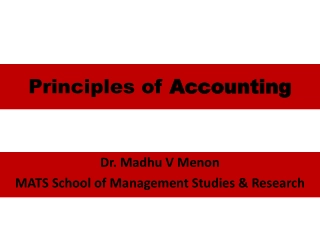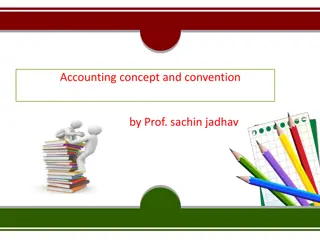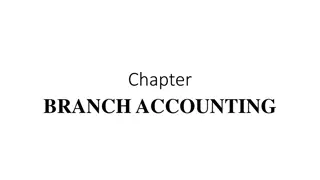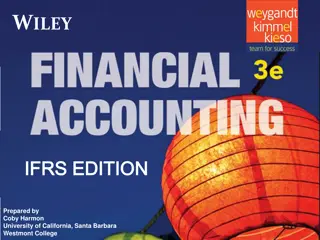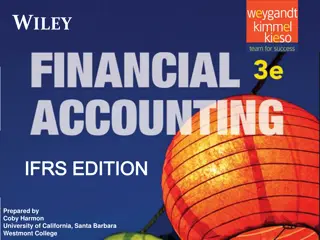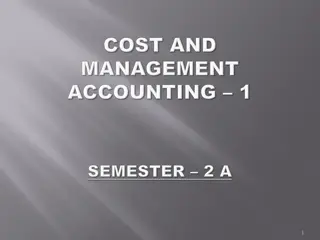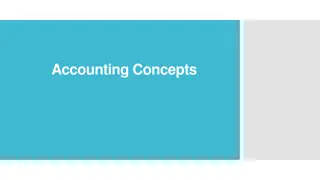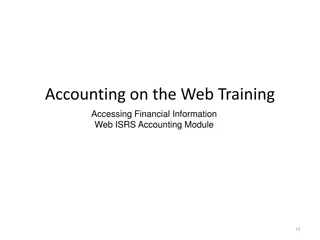Principles of Financial and Cost Accounting in Business
The content covers fundamental principles and concepts in financial and cost accounting, including the accounting process, accounting equation, types of accounts, ledger format, and the double-entry principle. It provides examples of transactions affecting the accounting equation and explains the relationship between assets, liabilities, and owner's equity. The key topics discussed are vital for understanding the basics of accounting practices in business and finance.
Download Presentation

Please find below an Image/Link to download the presentation.
The content on the website is provided AS IS for your information and personal use only. It may not be sold, licensed, or shared on other websites without obtaining consent from the author.If you encounter any issues during the download, it is possible that the publisher has removed the file from their server.
You are allowed to download the files provided on this website for personal or commercial use, subject to the condition that they are used lawfully. All files are the property of their respective owners.
The content on the website is provided AS IS for your information and personal use only. It may not be sold, licensed, or shared on other websites without obtaining consent from the author.
E N D
Presentation Transcript
THE INSTITUTE OF CHARTERED ACCOUNTANTS OF SRI LANKA POSTGRADUATE DIPLOMA IN BUSINESS AND FINANCE - 2015/2016 Principles of Financial and Cost Accounting Thilanka Warnakulasooriya B.Com Special, ACA,MBA-Fin
Accounting Process Accounting out put Accounting Input (Events & Transactions) Accounting Process (Financial Statements) Every Business transaction has two fold aspects called Debit & Credit. Double Entry system transactions are recorded in terms of debits and credits. Since a debit in one account will be offset by a credit in another account
Accounting Equation Mathematical presentation of the relationship between resource providers and resource holders . At any given time aggregation of the equity & the total liabilities of an accounting unit should be equal to total assets of the Organization. Assets= Liabilities Ownership can be divided in to two Internal Ownership or capital External Ownership or Liabilities
Ownership can be divided in to two Internal Ownership or capital External Ownership or Liabilities Therefore Accounting Equation is Assets= Capital + Liabilities
Ex: Show how following transactions in affect Accounting Equation 1. Mr. Kamal Start a Business by investing cash of 100,000 , Land of 150,000 ,plant & machinery of Rs. 200,000. 2. Purchase goods of Rs. 50,000 on cash 3. Purchase goods of Rs. 100,000 on credit 4. Sold goods worth of Rs. 10,000 for Rs. 15,000 on cash 5. Paid Utility bills of Rs. 5000 6. Drawing cash of Rs, 6000 for personal use. 7. Settled Rs. 20,000 of Creditors 8. Sold goods worth of 12,000 for 16,000 on credit basis 9. Received Rs, 10,000 from Debtors 10. Drawing Rs.5,000 goods for personal use
Accounts Accounts use to record transactions. Normally called ledger accounts Type of Accounts 1. Asset Accounts 2. Liability Accounts 3. Capital Accounts 4. Income Accounts 5. Expense Accounts
Format of Ledger Account T account debit Credit Date Description Page No Value Date Description Page No Value
Double Entry Principle According to the double entry Principle each transactions gives a dual side impact and those dual side are recorded in the Ledger Account Assets/ Expenditure account Debit Increase ( + ) Capital/ Liabilities/ Income Accounts Debit Credit Decrease ( -) Increase (+) Credit Decrease ( - )
Fill The following Table Ledger Account Increase Decrease Generally the side in Higher Value Asset Account Expense Account Liability Account Income Account Capital Account
Fill The following Table Ledger Account Increase Decrease Generally the side in Higher Value Asset Account Expense Account Liability Account Income Account Capital Account
Ex: Write the double entry for following transitions Transaction Relevant Ledger Account Debit Credit Owner invest Rs. 10,000 cash Purchase Machinery for Rs. 12,000 Paying Electricity bill of Rs 2,000 Purchase Rs, 17,000 goods on cash basis Receipt of Rs. 12,000 from debtors Settle Rs, 5000 Creditors Obtain a bank loan of Rs, 50,000 Write of bad debt of Rs, 500 Credit sales of Rs. 50,000 1. 2. 3. 4. 5. 6. 7. 8. 9. 10. Drawing of cash of Rs. 10,000 11. Credit Purchases of goods of Rs,. 40,000 12. Discounts given to debtors Rs. 2,000
Accounting Process Indentify Transaction & events Classifying Transactions & events Recording in primary books Preparing adjusted trail balance Preparing the Trail balance Accounting the transactions Prepare Financial Statements Brought forwarding the balances to next year
Transactions initiating through Source Documents includes transaction values and other relevant information i.e: Receipt, Invoice Data captured in source documents is recorded in the Primary books Recording batch total or individual figures in ledger account Prepare financial statements from balances obtained by balancing the general ledger.
Primary Books or Journal Transaction Source Document Ledger Account Receipt of Cash Receipt Cash Book Cash Book Cash Payment Payment Voucher Cash Book Cash Book Purcahse Journal/ Purchase day Book Credit Purchase Purchase Invoice Purchse Account Purcahse Return Journal/ Return outward day book Purchase Returns Debit Note Purchse return Account Sales Journal/ Sales day book Credit Sales Sales Invoice Sales Account Sales Return Journal/ Return inward day book Sales Return Credit Note Sales return Account Petty cash expenses Petty Cash Voucher Petty Cash book Petty Cash book Purchase Fixed Assets, Bad debts, etc. Respective ledger accounts Journal Voucher General Ledger
Credit Transactions Purchase day Book Return outward day book Sales day book Return inward day book General Journal


